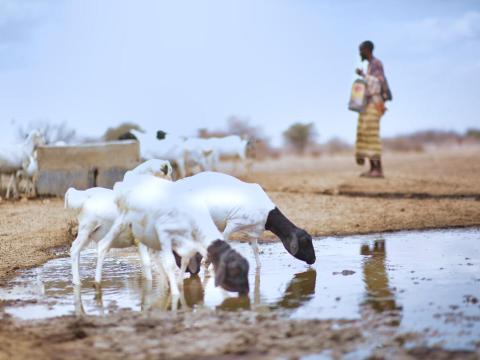Four ways vulnerable nations are paying for climate change

‘Unprecedented’ — it’s a term that’s thrown around a lot these days, and for good reason. With climate change supercharging the atmosphere and throwing weather patterns into disarray, the fallout is hitting the world’s most vulnerable people the hardest.
From children being exploited to rivers drying up, millions of lives and livelihoods are already being impacted with barely 1.5º C of warming.
With swift, coordinated action, the world still has time to avoid the very worst effects of climate change, but as many have experienced already, those living in poverty are in urgent need of help today.
1. Child Exploitation – Angola

A worrying pattern: climate change, food insecurity, and exploitation
Cavo has been forced into a life she never chose, and a changing climate is at the root of the problem.
In the Southern African nation of Angola, an unseasonable and prolonged drought linked to climate change has created a series of cascading social and economic issues. Food insecurity is such a problem for 15-year-old Cavo, that she, her mother, and grandmother often resort to eating heated up leaves to survive. Desperate, Cavo was forced into a life of prostitution just so her family can eat. This is the human cost of climate change, and the world’s poorest people are most affected.
2. Displacement – Niger

Climate change forces people to flee their homes
In 2019, after weeks of heavy rain, the Komadougou River in the Diffa region of Niger broke its banks, forcing more than 23,000 people to flee for their lives. Thousands of hectares of crops, farmland, and homes in the region were inundated and lost. After years of armed conflict and drought, this disaster exacerbated an already unstable country, leaving more than 10% of Niger’s population in need of humanitarian aid. Shockingly, 100 million people could be displaced by climate change by 2030 according to the Intergovernmental Panel on Climate Change.
3. Natural Disasters – Honduras

Two hurricanes in two weeks pushes Honduras to the brink
In 2020, just two weeks after Category 4 Hurricane Eta brought widespread flooding and forced hundreds of thousands of people from their homes, Honduras was pummeled by an unprecedented second Hurricane. Iota, a Category 5 super storm, was the record 30th hurricane of the 2020 Atlantic season and the latest maximum strength storm ever recorded.
The human toll from the twin storms was devastating. 4 million people were impacted, floods and landslides wiped out crops and homes, with 185,000 people displaced and 2.5 million with limited or no access to health services. This is the reality of climate change, and with many of the world’s poorest nations living in equatorial zones where hurricanes are most common, the outlook is set to worsen.
4. Lost Homes and Livelihoods — Solomon Islands

For generations, people who live in the Solomon Islands have been used to heavy storms during the cyclone season, but were able to live near the coastal waters and maintain their farms without many problems. But heavier storms in recent years have started destroying crops, homes, and even cemeteries. It’s forced farmers to move their farmland to higher elevations, which requires hiking up to an hour each way just to work. For others, it has destroyed their homes near the beach and forced them to move inland. And for others, they’ve been forced to move to neighbouring islands all together, abandoning their lives as well as the graves of their ancestors, which is something people feel guilty about in the culture.
This Earth Day, help protect the most vulnerable people against the impacts of the climate crisis.